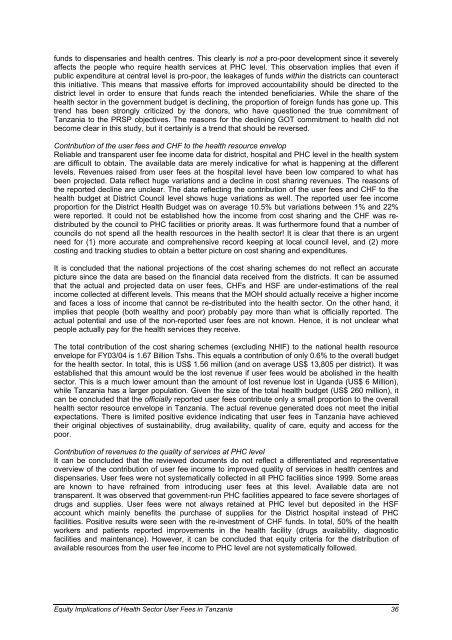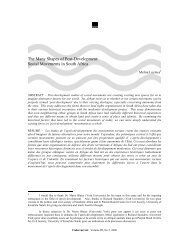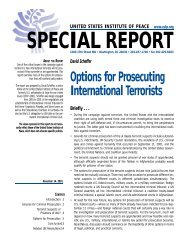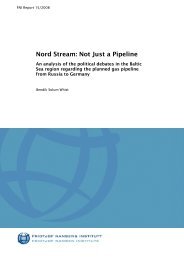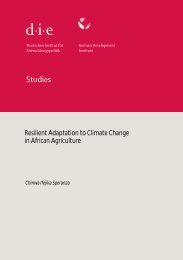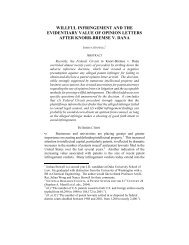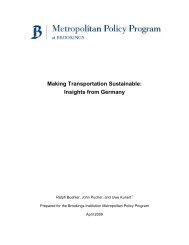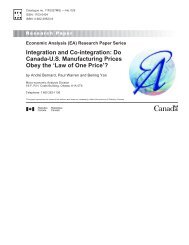equity implications of health sector user fees in tanzania
equity implications of health sector user fees in tanzania
equity implications of health sector user fees in tanzania
Create successful ePaper yourself
Turn your PDF publications into a flip-book with our unique Google optimized e-Paper software.
funds to dispensaries and <strong>health</strong> centres. This clearly is not a pro-poor development s<strong>in</strong>ce it severely<br />
affects the people who require <strong>health</strong> services at PHC level. This observation implies that even if<br />
public expenditure at central level is pro-poor, the leakages <strong>of</strong> funds with<strong>in</strong> the districts can counteract<br />
this <strong>in</strong>itiative. This means that massive efforts for improved accountability should be directed to the<br />
district level <strong>in</strong> order to ensure that funds reach the <strong>in</strong>tended beneficiaries. While the share <strong>of</strong> the<br />
<strong>health</strong> <strong>sector</strong> <strong>in</strong> the government budget is decl<strong>in</strong><strong>in</strong>g, the proportion <strong>of</strong> foreign funds has gone up. This<br />
trend has been strongly criticized by the donors, who have questioned the true commitment <strong>of</strong><br />
Tanzania to the PRSP objectives. The reasons for the decl<strong>in</strong><strong>in</strong>g GOT commitment to <strong>health</strong> did not<br />
become clear <strong>in</strong> this study, but it certa<strong>in</strong>ly is a trend that should be reversed.<br />
Contribution <strong>of</strong> the <strong>user</strong> <strong>fees</strong> and CHF to the <strong>health</strong> resource envelop<br />
Reliable and transparent <strong>user</strong> fee <strong>in</strong>come data for district, hospital and PHC level <strong>in</strong> the <strong>health</strong> system<br />
are difficult to obta<strong>in</strong>. The available data are merely <strong>in</strong>dicative for what is happen<strong>in</strong>g at the different<br />
levels. Revenues raised from <strong>user</strong> <strong>fees</strong> at the hospital level have been low compared to what has<br />
been projected. Data reflect huge variations and a decl<strong>in</strong>e <strong>in</strong> cost shar<strong>in</strong>g revenues. The reasons <strong>of</strong><br />
the reported decl<strong>in</strong>e are unclear. The data reflect<strong>in</strong>g the contribution <strong>of</strong> the <strong>user</strong> <strong>fees</strong> and CHF to the<br />
<strong>health</strong> budget at District Council level shows huge variations as well. The reported <strong>user</strong> fee <strong>in</strong>come<br />
proportion for the District Health Budget was on average 10.5% but variations between 1% and 22%<br />
were reported. It could not be established how the <strong>in</strong>come from cost shar<strong>in</strong>g and the CHF was redistributed<br />
by the council to PHC facilities or priority areas. It was furthermore found that a number <strong>of</strong><br />
councils do not spend all the <strong>health</strong> resources <strong>in</strong> the <strong>health</strong> <strong>sector</strong>! It is clear that there is an urgent<br />
need for (1) more accurate and comprehensive record keep<strong>in</strong>g at local council level, and (2) more<br />
cost<strong>in</strong>g and track<strong>in</strong>g studies to obta<strong>in</strong> a better picture on cost shar<strong>in</strong>g and expenditures.<br />
It is concluded that the national projections <strong>of</strong> the cost shar<strong>in</strong>g schemes do not reflect an accurate<br />
picture s<strong>in</strong>ce the data are based on the f<strong>in</strong>ancial data received from the districts. It can be assumed<br />
that the actual and projected data on <strong>user</strong> <strong>fees</strong>, CHFs and HSF are under-estimations <strong>of</strong> the real<br />
<strong>in</strong>come collected at different levels. This means that the MOH should actually receive a higher <strong>in</strong>come<br />
and faces a loss <strong>of</strong> <strong>in</strong>come that cannot be re-distributed <strong>in</strong>to the <strong>health</strong> <strong>sector</strong>. On the other hand, it<br />
implies that people (both wealthy and poor) probably pay more than what is <strong>of</strong>ficially reported. The<br />
actual potential and use <strong>of</strong> the non-reported <strong>user</strong> <strong>fees</strong> are not known. Hence, it is not unclear what<br />
people actually pay for the <strong>health</strong> services they receive.<br />
The total contribution <strong>of</strong> the cost shar<strong>in</strong>g schemes (exclud<strong>in</strong>g NHIF) to the national <strong>health</strong> resource<br />
envelope for FY03/04 is 1.67 Billion Tshs. This equals a contribution <strong>of</strong> only 0.6% to the overall budget<br />
for the <strong>health</strong> <strong>sector</strong>. In total, this is US$ 1.56 million (and on average US$ 13,805 per district). It was<br />
established that this amount would be the lost revenue if <strong>user</strong> <strong>fees</strong> would be abolished <strong>in</strong> the <strong>health</strong><br />
<strong>sector</strong>. This is a much lower amount than the amount <strong>of</strong> lost revenue lost <strong>in</strong> Uganda (US$ 6 Million),<br />
while Tanzania has a larger population. Given the size <strong>of</strong> the total <strong>health</strong> budget (US$ 260 million), it<br />
can be concluded that the <strong>of</strong>ficially reported <strong>user</strong> <strong>fees</strong> contribute only a small proportion to the overall<br />
<strong>health</strong> <strong>sector</strong> resource envelope <strong>in</strong> Tanzania. The actual revenue generated does not meet the <strong>in</strong>itial<br />
expectations. There is limited positive evidence <strong>in</strong>dicat<strong>in</strong>g that <strong>user</strong> <strong>fees</strong> <strong>in</strong> Tanzania have achieved<br />
their orig<strong>in</strong>al objectives <strong>of</strong> susta<strong>in</strong>ability, drug availability, quality <strong>of</strong> care, <strong>equity</strong> and access for the<br />
poor.<br />
Contribution <strong>of</strong> revenues to the quality <strong>of</strong> services at PHC level<br />
It can be concluded that the reviewed documents do not reflect a differentiated and representative<br />
overview <strong>of</strong> the contribution <strong>of</strong> <strong>user</strong> fee <strong>in</strong>come to improved quality <strong>of</strong> services <strong>in</strong> <strong>health</strong> centres and<br />
dispensaries. User <strong>fees</strong> were not systematically collected <strong>in</strong> all PHC facilities s<strong>in</strong>ce 1999. Some areas<br />
are known to have refra<strong>in</strong>ed from <strong>in</strong>troduc<strong>in</strong>g <strong>user</strong> <strong>fees</strong> at this level. Available data are not<br />
transparent. It was observed that government-run PHC facilities appeared to face severe shortages <strong>of</strong><br />
drugs and supplies. User <strong>fees</strong> were not always reta<strong>in</strong>ed at PHC level but deposited <strong>in</strong> the HSF<br />
account which ma<strong>in</strong>ly benefits the purchase <strong>of</strong> supplies for the District hospital <strong>in</strong>stead <strong>of</strong> PHC<br />
facilities. Positive results were seen with the re-<strong>in</strong>vestment <strong>of</strong> CHF funds. In total, 50% <strong>of</strong> the <strong>health</strong><br />
workers and patients reported improvements <strong>in</strong> the <strong>health</strong> facility (drugs availability, diagnostic<br />
facilities and ma<strong>in</strong>tenance). However, it can be concluded that <strong>equity</strong> criteria for the distribution <strong>of</strong><br />
available resources from the <strong>user</strong> fee <strong>in</strong>come to PHC level are not systematically followed.<br />
Equity Implications <strong>of</strong> Health Sector User Fees <strong>in</strong> Tanzania 36


